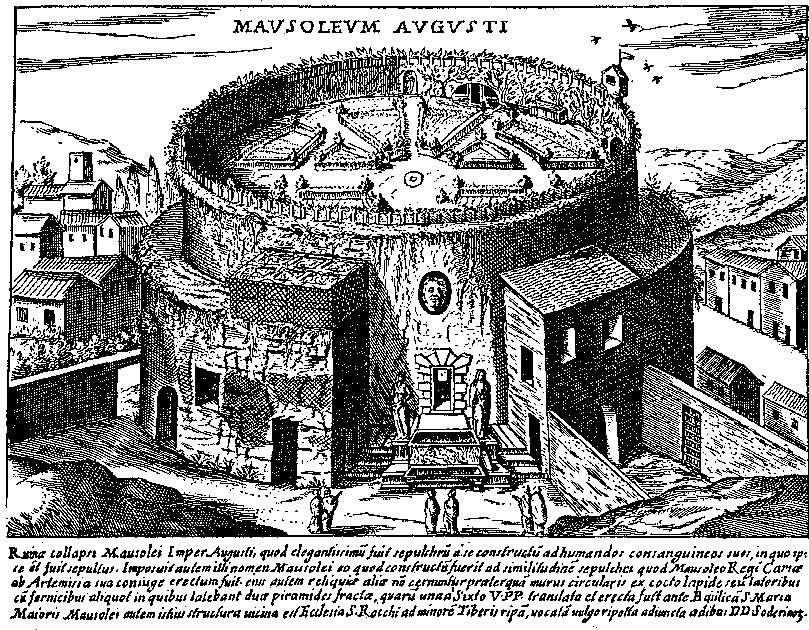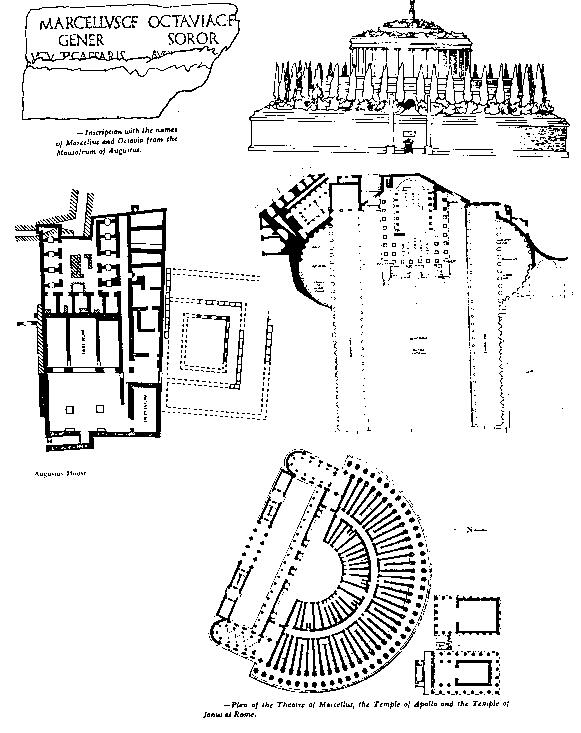 | ||||
The complex to which the Res Gestae belonged included the Mausoleum of Augustus, two obelisks, the Ara Pacis, the Ustrinum, and two pillars (mentioned in the text) on which the Res Gestae was carved.
Corpus Inscriptionum Latinarum I2 244: (calendar: referring to July 4, 13 B.C.)
FER(IAE) EX S(ENATUS) C(ONSULTO) Q(UOD) E(O) D(IE) ARA PACIS AUG(USTAE) IN CAMP(O) MAR(TIO) CONSTITUTA EST NERONE ET VARO COS.
"Holiday, by decree of the Senate, because on that day the Altar of Augustan Peace was founded in the Campus Martius, in the consulship of (Tiberius Claudius) Nero and (P. Quintilius) Varus."
Inscriptiones Italiae 13.2.117 (calendar: referring to 30 January, 9. B.C.):
FERIAE EX S(ENATUS) C(ONSULTO) QUO[D EO] DIE ARA PACIS AUGUSTA[E IN CAMPO ] MARTIO DEDICATA [E]ST DRUSO ET CRISPINO C[OS].
"Holiday, by decree of the Senate, because on that day the Altar of Augustan Peace was dedicated in the Campus Martius, in the consulship of Drusus and Crispinus."
Ovid Fasti I. 709-722:
Ipsum nos carmen Pacis deduxit ad aram,
haec erit a mensis fine secunda dies.
Frondibus Actiacis comptos redimita capillos,
Pax, ades et toto mitis in orbe mane!
Dum desint hostes, desit quoque causa triumphi,
tu ducibus bello gloria maior eris.
Sola great miles, quibus arma coerceat, arma,
canteturque fera nil nisi pompa turba.
Horreat Aeneadas et primus et ultimus orbis:
si qua parum Romam terra timebat, amet!
Tura, sacerdotes, pacalibus addite flammis,
albaque perfusa victima fronte cadat.
Utque domus, quae praestat eam, cum pace perennet,
ad pia propensos vota rogate deos!
Suetonius, Augustus 100-101:
Obiit in cubiculo eodem, quo pater Octavius, duobus Sextis, Pompeio et Appuleio, consulibus XIIII Kal. Sept. hora diei nona septuagesimo et sexto aetatis anno, diebus quinque et triginta minus. Corpus decuriones municipiorum et coloniarum a Nola Bovillas usque deportarunt noctibus propter anni tempus, cum interdiu in basilica cuiusque oppidi vel in aedium sacrarum maxima reponeretur. A Bovillis Equester Ordo suscepit urbique intulit atque in vestibulo domus collocavit. Senatus et in funere ornando et in memoria honoranda eo studio certatim progressus est, ut inter alia complura censuerint quidam funus Triumphali porta ducendum, praecedente Victoria quae est in Curia, canentibus neniam principum liberis utriusque sexus; alii, exequiarum die ponendos anulos aureos ferreosque sumendos; nonnulli ossa legenda per sacerdotes summorum collegiorum. Fuit et qui suaderet apellationem mensis Augusti in Septembrem transferendam, quod hoc genitus Augustus, illo defunctus esset; alius, ut omne tempus a primo die natali ad exitum eius saeculum Augustum appellaretur, et ita in fastos referretur. Verum adhibito honoribus modo, bifariam laudatus est: pro aede divi Iuli a Tiberio et pro Rostris veteribus a Druso Tiberi filio ac senatorum umeris delatus in Campum crematusque. Nec defuit vir praetorius, qui se effigiem cremati euntem in caelum vidisse iuraret. Reliquias legerunt promores equestris ordinis tunicati et discincti pedibusque nudis, ac Mausoleo condiderunt. Id opus inter Flaminiam Viam ripamque Tiberis sexto suo consulatu (28 B.C.) exstruxerat circumiectasque silvas et ambulationes in usum Populi iam tum publicarat
(104) Iulias, filiam neptemque, si quid iis accidisset, vetuit sepuclro suo inferri. Tribus volumnibus, uno mandata de funere suo complexus est; altero, indicem rerum a se gestarum, quem vellet incidi in ahenis tabulis, quae ante Mausoleum statuerentur; tertio, breviarium totius imperii.
"(Augustus) died in the same chamber as his father Octavius had, in the year in which the two Sextuses, Pompeius and Appuleius, were consuls (A.D. 14), on the 19th of August, at the ninth hour of the day (3 p.m.), in the seventy sixth year of his life, thirty five days before his birthday. The municipal and colonial senators carried his body as far as Bovillae, during the nights because of the time of the year, and each night it would be placed in the Basilica of the local town or in the sanctuary of the most important temple. From Bovillae the Equestrian Order took it up, brought it to the City and placed it in the Vestibule of his residence. The Senate, both in arranging the funeral and in honoring his memory, competed with one another with such eagerness, that among many other things they decreed that the funeral procession should proceed through the Triumphal Gate and be led by the Statue of Victory which is in the Senate House, with the children of the aristocracy of both sexes singing the funeral dirge; others proposed that, on the day of the burial, their gold rings should be put aside and iron ones worn instead; some that his bones be gathered up by the priests of the major colleges. There were others who proposed that the name of the month ‘August‘should be transferred to the month September, because September was the month in which Augustus was born and August that in which he died; another that the entire period between the birth and death of Augustus should be called the ‘Saeculum Augustum ‘ and referred to in that fashion in the Fasti. In fact, though his honors were kept moderate, he was given two eulogies, one in front of the Temple of the God Julius by Tiberius, the other at the Rostra by Drusus the son of Tiberius, and he was carried on the shoulders of the Senators to the Campus Martius and cremated. Nor was there lacking a Senator of Praetorian rank who swore that he had seen the image of the man being cremated ascend into heaven. The leaders of the Ordo Equester, wearing tunics, unbelted, and barefoot, gathered up the remains and placed them in the Mausoleum. (Augustus) had built this edifice between the Via Flaminia and the Tiber bank in his sixth consulship (28 B.C.), and surrounded it with groves and walkways which he opened to the use of the public."
He forbade the two Julias, his daughter and granddaughter, to be buried in his tomb if something should happen to them. Of the three sealed rolls, one contained the instructions for his funeral; the second, the Res Gestae Divi Augusti, which he wanted to be inscribed on bronze tablets which would stand in front of the Mausoleum; the third, an accounting of the entire empire.
L‘ année épigraphique (1928) #2: (Memorial plaques on the outer drum of the Mausoleum Augusti)
MARCELLVS . C . F | GENER | AVGVSTI . CAESARIS
"Marcellus, son of Gaius Marcellus, nephew of Augustus Caesar."
OCTAVIA . C . F | SOROR | AVGV(STI . CAESARIS)
"Octavia, daughter of Gaius Octavius, sister of Augustus Caesar."
CIL VI. 886. 1 The marble burial container for the gold urn with the ashes of Agrippina the Elder (Capitoline Museums):
OSSA | AGRIPPINAE . M . AGRIPPAE . F | DIVI . AVG . NEPTIS . VXORIS | GERMANICI CAESARIS | MATRIS . C . CAESARIS . AVG . GERMANICI . PRINCIPIS.
"The bones of Agrippina the daughter of Marcus Agrippa, granddaughter of The Divine Augustus, wife of Germanicus Caesar. Mother of Gaius Caesar Augustus Germanicus, the Princeps."
Tacitus Annales XVI. 6:
corpus (Poppaeae Sabinae) non igni abolitum, ut Romanus mos, sed regum externorum consuetudine differtum odoribus conditur tumuloque Iuliorum infertur
"the body (of Poppaea) was not consumed by fire, as the Roman custom is, but, according to the custom of foreign rulers, it was enbalmed with aromatic substances and placed in the Tomb of the Iulii."
Aurelius Victor, The Caesars 12.12:
corpus (Nervae Principis) a Senatu, ut quondam Augusti, honore delatum in Sepulcro Augusti sepultum est. eo die, quo interiit, solis defectio facta est.
"The body (of the Emperor Nerva [96-98]) carried as an honor by the Senate, as was once the body of Augustus, was buried in the Mausoleum Augusti. On the day of the interment there was an eclipse of the sun."
 |
Plans